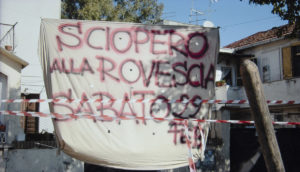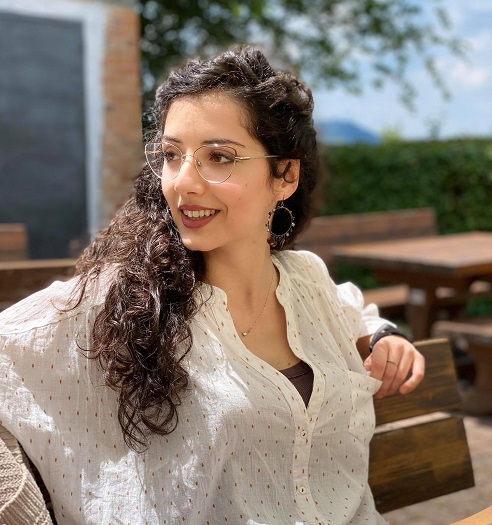Today in the spaces of AlbumArte Paradigma, Sandro Mele’s personal exhibition curated by Raffaele Gavarro, open to visitors until October 31st. The artist – of Apulian origin and active in Rome – partly due to his closeness to his personal events, partly as a reaction to daily events, feels he must carry on with his artistic work almost a form of militancy against some forms of injustice. Each work is for him an instrument at the service of the message to be communicated, a political and denunciation message. Mele searches for, studies and tells stories on the edge of oblivion and does so using different expressive languages that coexist with each other. This is what happens in the exhibition with the strong and – as pointed out by the curator – deliberately looming presence of the 75 portraits on paper of the members of the Commission for the Italian Constitution.
As Gavarro explains «We have forgotten many of those people and of many of them only passport-sized photos remain. Giving them back an image through Mele’s harsh painting, delimited by the essentiality of black, gray and white has triggered more than a simple remembrance, it has made them concretely part of the present”. And the other works on display also speak of the present: the installation that fills the floor of the space with helmets that become flower boxes and allude to the size of the square; the video in the projection room dedicated to the initiatives of the Certosa di Roma Committee; the background sound with Piero Calamandrei’s speech to the students in 1955.” The political conception of the 75 that oversees the drafting of the Constitution, also present in Calamandrei’s speech – says the curator – becomes the daily practice of the communities, is renewed with them” .
The themes – current and urgent – are addressed by the artist with sensitivity and originality and are linked to the paradigm referred to in the title of the exhibition. The latter – says Gavarro – “becomes something more than a suggestion, wanting to indicate in the founding model as well as in the one practiced silently and obstinately by people and communities, the possibility of having a reference, an inspiration, a concrete lever for re-building something that erases the mistakes of the past, thus avoiding going back to what some recklessly indicate as normality».
We asked the artist some questions about the works featured in the exhibition.
Ornella D’Agnano: It is not the first time that you deal with political and social issues with your works, indeed often your art is in close dialogue with politics. In this exhibition you focus mainly on the Italian Constitution. The 75 portraits of the members of the Commission for the Constitution are exhibited and the words of Piero Calamandrei to the students of the University of Milan (January 25, 1955) resound in the exhibition space. What prompted you to approach and deepen this theme? What do the 75 faces you have decided to hide your gaze from with a white band mean to you?
Sandro Mele: In the history of our Constitution there have been numerous attempts to modify it, just remember that of Berlusconi in 2006 and that of Renzi in 2016. However, they have not yet succeeded, thanks to a great democratic response from the Italian people. I sincerely hope that with the Referendum on 21 September 2020, another “hole in the water” will occur and that all citizens will express their will to preserve the Constitution by voting NO. I firmly believe that it is not necessary to change Articles 56, 57 and 59, this would imply a sharp decrease in representatives, but to save money it is necessary to reduce the salaries of parliamentarians. This would be an act of responsibility and real closeness to the Italian people, especially in this difficult moment. Our Constitution is one of the least attackable, as well as being one of the most beautiful in the world; the constituent assembly has done an exceptional job, which is why the Constitution must not be changed at all. We must fight to make it known and above all our politicians should commit to make it implemented. This reflection is fundamental in my work, in fact the white band that I placed on the eyes of the portraits refers to a feeling of shame: I believe that if the fathers and mothers of our Constitution were still alive they would be ashamed of how today this is not observed.
O.D.: Calamandrei, 65 years ago, spoke of giving spirit and life to the Constitution, but also of political indifferentism which he defined as an offense to the Constitution, a “disease of the young”. Can we consider your work as your personal way of fighting this indifferentism, as a reaction to the events of the contemporary?
S.M.: Calamandrei’s audio is very topical and I always listen to it with great emotion. As soon as I listened to it, I fell in love with it and then I thought about using it in my work. Indifference is a major civil scourge, Calamandrei makes it clear: we are the ones who make our Constitution work. I am happy that civic education has been restored in educational programs, in past years it was lost track, but from the next school year it will return to having that fundamental role in the transmission of civic values to the new generations. In my work I have always tried to combat indifference by providing information through the voice of the people, that of the oppressed, the real protagonists of a story: in this project the voice passes to the constituent fathers who, even through the figurative arts, remember that they have us put their face and heart to donate an extraordinary constitutional charter.
O.D.: The floor of the exhibition space hosts various motorcycle helmets that become containers of earth, plants and flowers. In 2013 you made Primo Maggio, a helmet that contained a cactus; in 2017 the helmets became many more and featured red flowers in the Piazza installation. You have chosen to resubmit the installation. What does it represent for you? Why do helmets become a symbol of the square?
S.M.: After the G8 I noticed that helmets were increasingly present in the squares, used as protection not only for the police, but also for journalists, photographers and ordinary people participating in the demonstrations: a strong symbol of the new struggle of the squares. The helmets. My reflection starts from there and then changes. I have made works with helmets on several occasions: on May 1, 2013 I planted a cactus inside a white helmet and dedicated it to the workers’ struggle; in an exhibition in Lerici I used other helmets for an installation regarding the G8 and finally I used a black helmet with an olive tree bonsai, Art. 21 (2018), as the cover image for my latest editorial project entitled Gasnero. Gradually I started using helmets of different colors, until I reached the red which is one of the colors that belongs to me most ideologically. The choice of the helmet as a symbolic object of struggle is combined with the plant, an element that praises life.
O.D.: Often your works are also tools with which you choose to tell stories. You tell the stories of people whose voices are often not heard or give back identity and dignity to those who have been forgotten. I am thinking, for example, of Raccontami di Cerano (2010), a video work in which the farmers of the area – no longer having a land to work due to the damage caused by the coal-fired power plant – tell about their condition; or Per Hyso Telhara (2017) dedicated to the young Albanian laborer killed by corporals in Puglia in 1999. On this occasion, you choose to tell, with a video, about the Committee of the Certosa district of Rome, linked to the memory of Ciro Principessa. What brought you closer to the people of the neighborhood? What is their story?
S.M.: Initially I wanted to tackle the issue of neighborhood committees involving more realities and introducing theirs too, but it was an embryonic idea. Studying I realized that I had to face only one, that of the Charterhouse Committee. My studio is in the Certosa district in Torpignattara. I have seen the Certosa Committee grow year by year, fight after fight. I have great respect for them, both as individuals and as a neighborhood committee. I have always followed them with great political interest and I participated year after year in their party dedicated to Ciro Principessa, a young boy killed by a stab in the chest by a fascist of the MSI in 1979, in the headquarters of the Communist Party in Torpignattara. The video explains how the neighborhood committee is replaced by the institutions. This phenomenon is more and more frequent in Rome, with always a greater absence of the state to the detriment of the citizen.
Ornella D’Agnano
Info:
Paradigma
23.09.20 – 31.10.20
AlbumArte
via Flaminia 122, Roma
 Ritratto di Sandro Mele
Ritratto di Sandro Mele
 Sandro Mele, Paradigma, 2020, Piero Calamandrei, pittura, carbone, gesso e cartoncino su carta, installazione composta da 75 ritratti cad. cm. 70 x 100
Sandro Mele, Paradigma, 2020, Piero Calamandrei, pittura, carbone, gesso e cartoncino su carta, installazione composta da 75 ritratti cad. cm. 70 x 100
 Sandro Mele, Certosa, 2020. Still – durata video 15′
Sandro Mele, Certosa, 2020. Still – durata video 15′
 Sandro Mele, Lucha, 2010. Bottega Immagine – Centro Fotografia Milan, 5 pezzi cm. 200×100 cad. (cm 200×500), piastrelle, legno, colla per piastrelle con struttura in legno
Sandro Mele, Lucha, 2010. Bottega Immagine – Centro Fotografia Milan, 5 pezzi cm. 200×100 cad. (cm 200×500), piastrelle, legno, colla per piastrelle con struttura in legno
 Sandro Mele, Primo Maggio, 2013, casco, terra, cactus, cm 30 x 22 x 23
Sandro Mele, Primo Maggio, 2013, casco, terra, cactus, cm 30 x 22 x 23
 Sandro Mele, Per Hyso Telhara,2017, cm 150 x 150, foto su tela, pittura, carbone
Sandro Mele, Per Hyso Telhara,2017, cm 150 x 150, foto su tela, pittura, carbone

Born in Puglia (Italy), after a three-year degree in Cultural Heritage at the University of Salento (Lecce), she deepened her study of contemporary art, graduating in Visual Arts at the University of Bologna, where she currently lives and works. Author of the critical essay “Museum and Neutrality”. Member of the Muri di Versi Cultural Association. She believes that art is a powerful tool capable of arousing reflections and creating relationships.






NO COMMENT